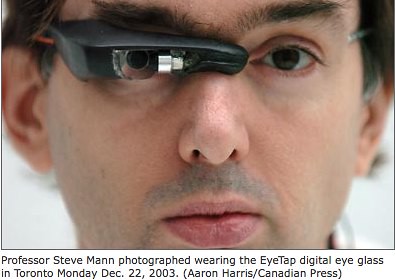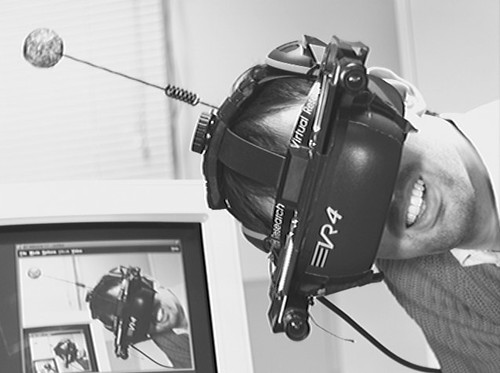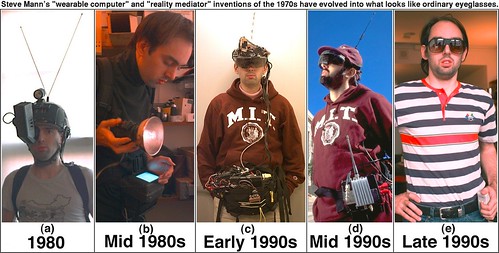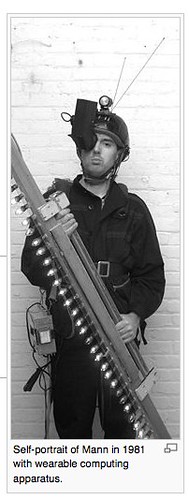Computing sucks. We sit scrunched over our computers, and have to deal with the eventual back problems of sitting in place for too long. We have repetive stress injuries, fatigue, and lack of mobility. But some people don’t. And they refused to have the computer colonize their mobility in this fashion.
Borg Group
I was at MIT’s Media Lab last week. The guy I was with pointed to the third floor and talked about the people who came out of it. It was as if the third floor were an incubator for ideas. The third floor had cyborgs. Or ‘borgs’ as they were called when they were first there. These borgs were the first to make wearable computing reality. From lugging tens of pounds of heavy equipment on their backs and bearing with the consequences, they made computers conform to the shape of their bodies, not their bodies to the shape of the computers we use today.
Interesting Beginnings
Lifecasting
It is important to note that Steve Mann was one of the borgs behind the beginning of wearable computing. He was also an early lifecaster — of the kind we recognize as iJustine today (in its most consumeristic form). He had this idea that if he were to be watched all of the time by survelliance cameras, he could watch the world back. This idea he called “sousvellience”, or survelliance by the individual.
Many media sources have cited Mann as “the world’s first cyborg”, from his early work with wireless wearable webcams.[14] Mann’s publications include the book Cyborg: Digital Destiny… and the textbook Intelligent Image Processing, describing his early adoption of an alternative life style with significant and interesting ideas. In 2001, filmmaker Peter Lynch directed Cyberman, a film about Mann’s life and inventions”. [1. http://en.wikipedia.org/wiki/Steve_Mann]
Now a tenured professor at the Department of Electrical and Computer Engineering at the University of Toronto, Steve Mann continues to push the boundaries of how humans and computers can cocreate each other, as well as amplify human action.
The Evolution of Wearables
Computing Lightness
Everything is becoming lighter and lighter. The industrial revolution saw the rise of heavy, unwieldy machines, but as time progressed, interfaces became liquid (iPhone), and computing became detached from cables and cords — and weight. Steve Mann took advantage of this as soon as he realized it. Because of this, he’s light years ahead of the rest of us lumbering beasts.
——————-
Some of Steve Mann’s recent publications that are available on the WWW:
Comparametric Equations (the mathematical theory of computer mediated reality)
http://computer.org/computer/backissu.htm (scroll down to the feature article of Feb.’97)
The complete article is also available from: http://n1nlf-1.eecg.toronto.edu/ieeecomputer
See also: http://www.wearcam.org/chi97 and http://www.wearcam.org/personaltechnologies and http://www.wearcam.org/historical/
For a light overview of the invention, see: http://www.wearcam.org/judith_gaines_und.gif or if you want more resolution: http://www.wearcam.org/judith_gaines.jpg
Mathematical theory (video orbits) behind his “image compositing” work, see Sep.’97 issue of IEEE Transactions on Image Processing http://n1nlf-1.eecg.toronto.edu/tip.ps.gz
A small gallery of images is located at http://n1nlf-1.eecg.toronto.edu/orbits/gallery.html and a brief description at http://n1nlf-1.eecg.toronto.edu/orbits/
Take a look at some other embodiments of his “WearComp” (wearable computer) invention (e.g. WearComp1, WearComp3, etc.): http://www.wearcam.org/steve5.jpg
Other pictures of Mann’s “WearComp” invention as it has evolved over more than 20 years.






One Trackback
[...] Steve Mann says that we’ll be able to download eyeglass prescriptions in the future. Henry Jenkins [...]